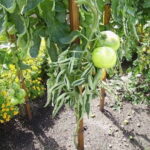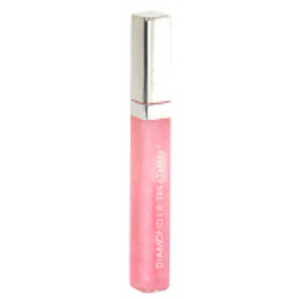Topsy Turvey, they are widely advertised on TV and in stores.
Grow tomato plants upside down; no muss, no fuss, and loads of tomatoes are yours for the harvest with minimal effort, no weeding, and the “benefits” ramble on.
Are these upside down planters all they claim to be?
To make a fair comparison, a tomato plant (Early Girl) was purchased along with the same variety in a Topsy Turvey planter.
Both were about the same size when the comparison began.
Early on, the Topsy Turvey (herein referred to as TT) tomato plant instantly began growing and flourishing while the ground planted tomato stalled in growth.
Within days it became very apparent that the TT tomato required much more frequent watering as the pot allowed the extra water to drain from the planter. Ensure if you go this route, that you place your planter where the runoff water will not harm the surroundings. For example, a porch area you do not want wet would not be advisable.
The TT plant displayed buds early on, but the in ground tomato quickly caught up.
One aspect of the TT planter not initially taken into consideration was the strength of local “breezes” (upwards of 40 mph or higher during summer storms). The TT planter had to be constantly moved because of the potential for winds to damage the fragile plant as it was growing.
Another noticeable trait appeared as the plants grew. The plant in the TT still attempts to grow UPRIGHT, even while hanging upside down. Once the plant becomes too heavy to do this, it settles to a hanging position, but the main stem of the plant is twisted in the process. The result are cracks in the stem of this main supply of water and nutrients to the plant. It exposes the internal surface of the stem to the elements.
While both plants did bud and flower, the in ground tomato plant had many more flowers grow into tomatoes than the TT plant did.
With a total of six plants in this study, two in TT planters, two in the ground in one location, and two in a different location in the ground, the following are observations of this “study.”
The plants in the TT planters contracted “blight” a spore that attacks plants too close together that prevent the foliage from drying after rain, dew, etc. This disease also infects stressed plants. It should be noted that the TT plants were hung a distance of 4′ apart (from nearest side of each plant), which should have been adequate distance to not be a contributing factor in the blight infection.
Healthy plants are more resistant to blight and can be in an infected area without contracting the disease.
Of the six plants, they compare thus:
The plants in the TT did the worse. Very minimal fruit bearing, with many tomatoes lost to disease. The need for constant watering due to the hanging basket of potting soil constantly exposed to the heat of the day most likely contributed to this condition. The twisted main stem, damaged on both hanging plants when the weight of the plant became more than it could hold upright also was a probable stress contributor.
One of the TT planters never produced an edible tomato, instead withering away with the buds dying and dropping off before pollination.
The second TT planter produced few edible tomatoes and required a vast amount more of work in daily watering, fertilizing, etc to get there.
Two plants in one location grew to large proportions and were loaded down with edible fruit. Two plants in the alternate location did not bear as much fruit as the other two ground planted tomatoes, but they were exposed to hotter sun for longer periods during the day. However, they did not contract the blight that infected both hanging plants.
Bottom line: The Topsy Turvey may work well for some, however, if you have the location in your yard, it is best to plant tomato plants in the ground with added mulch to keep weeds down and moisture in the soil. The time spent weeding if you mulch is minimal when compared to the amount of work required to grow tomatoes in Topsy Turvey planters.
The planter’s design of allowing excess moisture to drain is beneficial in that it prevents the roots from sitting it water, but also detrimental in the plant may not be able to draw off the needed water fast enough before it has drained away.
The Topsy Turvey planters may perform better with other varieties of plants, such as cucumbers, etc, but in the study conducted here, the tomato plants were stressed from their natural upward growing, winds, lack of moisture (even though watered daily), and disease.
If you do end up with diseased tomato plants, particularly if blight infected, ensure you destroy the remnants of the plant before winter. The spores can live on the old plant foliage and soil through winter to infect a new crop next year if the tomatoes are planted in the same location. Blight can even spread to other plants such as potatoes. Dispose of or bury the remains of infected plants to reduce the chance of re-infection.
As for upside down tomato gardens, it may be best to leave the upside down hanging to those things better suited for it, such as bats. Tomatoes are meant to grow up and do best when allowed to grow in that manner.






